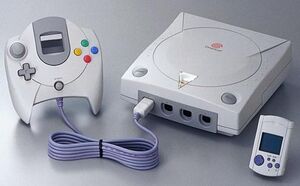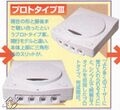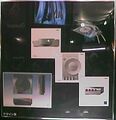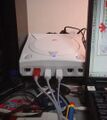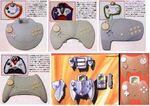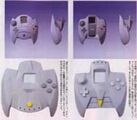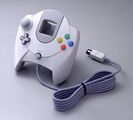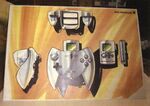Difference between revisions of "History of the Sega Dreamcast"
From Sega Retro
| Line 70: | Line 70: | ||
By mid-1998 the internals of the Dreamcast had been finalised, though a final colour had not yet been chosen. Interestingly Sega had originally planned to distance its company name from the brand - unlike production Dreamcasts (and North American advertising), no "SEGA" lettering was to be found on the console, likely in an attempt to hide the history of the Saturn, [[Sega 32X]] and [[Sega Mega-CD]]. | By mid-1998 the internals of the Dreamcast had been finalised, though a final colour had not yet been chosen. Interestingly Sega had originally planned to distance its company name from the brand - unlike production Dreamcasts (and North American advertising), no "SEGA" lettering was to be found on the console, likely in an attempt to hide the history of the Saturn, [[Sega 32X]] and [[Sega Mega-CD]]. | ||
| + | |||
| + | ===Windows World Expo Tokyo 98=== | ||
| + | Between the 1st and 4th of July, 1998, Microsoft held their own Japanese expo for upcoming Windows products. Among those, the Windows CE-compatible Dreamcast, still not in its final form. | ||
| + | |||
| + | Unlike the Sega New Challenge Conference where prototype Dreamcasts were kept in glass cases or behind closed doors, here the console could be picked up and even powered on, confirming that "something" was in the shell, even though it wasn't connected to a television. | ||
| + | |||
| + | The Dreamcast on display still lacked its final shell, as evidenced by the lack of "Powered by Windows CE" text next to the controller ports. Instead, a crudely attached sticker was placed on the front of the console, with a promise that the final version would have this message printed on the shell itself{{fileref|GamersRepublic US 04.pdf|page=12}}. | ||
| + | |||
| + | <gallery> | ||
| + | WWETokyo98 DC 1.jpg | ||
| + | WWETokyo98 DC 2.jpg | ||
| + | WWETokyo98 DC 3.jpg | ||
| + | </gallery> | ||
===[[Sega New Challenge Conference II]] and [[Tokyo Game Show '98 Autumn]]=== | ===[[Sega New Challenge Conference II]] and [[Tokyo Game Show '98 Autumn]]=== | ||
Revision as of 10:14, 9 January 2016
Contents
Development
Pre-announcement
Sega Saturn
Such was the state at Sega at the time, a successor to the Sega Saturn was being considered by the firm even before the console had been released. After a series of talks with Nintendo for a CD-based add-on for the Super Nintendo console broke down, Sony unveiled their stand-alone PlayStation system in November 1993, rattling Sega's management considerably. Sega had not seen Sony as a threat until this point, worried instead of what Nintendo may have had in-store with their presumed successor to the Super Nintendo.
When it emerged that Sony's hardware may have been more powerful than Sega's, three possible options crossed CEO Hayao Nakayama's path. Either to press on with the Saturn project as is, upgrade it, or scrap it entirely in favour of another, superior console. As such, rumours of a "Saturn 2" console appeared as early as September 1994, possibly in the form of an add-on (similar to the Sega 32X) or as a replacement to the original Saturn within one or two years.
Ultimately the decision was made to enhance the Saturn, and with the help of Hitachi, extra processors were added to make the console arguably more powerful than the PlayStation. Unfortunately this came at a price, and the added complexities of this rushed design meant very few programmers could tap in to the Saturn's true potential.
"Saturn 2"
Though the Saturn sold fairly strongly in Japan during 1995, talks of the Saturn 2 were still on the table, as developers across the world were becoming ever more displeased with Sega's recent offering. It emerged that the Saturn 2 project was no longer in the exclusive hands of Sega - Lockheed Martin, who had assisted the company with the graphics powering the Sega Model 1 and Sega Model 2 arcade boards, were now in charge of the Saturn 2 project, with a focus primarily on graphical power.
At the time, Lockheed Martin were working on their "Real3D" series of chipsets for Windows-based PCs, and the Saturn 2 was rumoured to use the R3D/100 chipset as a base for its graphics[1]. PC graphics were not yet "standardised" at this time - DirectX had yet to be invented and though Lockheed Martin were working with the now widely used OpenGL technology, there were a vast array of competing video cards on the market.
Doubts began to be cast towards the end of the year, due to Sega's increased frustrations with Lockheed Martin, who were simultaneously working on the Sega Model 3 arcade platform. The Model 3, once set for release in late 1995, wasn't due to be seen until mid-1996, causing Sega to temporarily lose its competitive edge in the arcades.
At this time, Sega parntered with the rising graphics company, NVIDIA, who based their first video card, the NV1 off the Sega Saturn hardware (even allowing for Saturn controllers to be plugged in via a second board). NVIDIA had a hard time persuading Sega that the technology was the future, however - Sega were already sceptical due to the PlayStation's early success, and even though Sega converted several Saturn games to benefit from the NV1, sales of the video card were poor. NVIDIA reportedly started to work on a successor, the NV2 but the project was shelved. Had it been finalised, the technology behind the NV2 would likely have likely replaced the R3D/100 graphics chipset for Sega's next console.
It has been rumoured that Sega made a fairly bold decision in early-1996, almost abandoning their Model 3 platform entirely. At the time, rival 3DO was producing its own arcade platform, the M2, and Sega decided to order some development kits in a deal which would see them provide the system exclusively with games[2]. Inevitably a mixture of egos and reports of poor performance led to Sega abandoning the M2 project shortly afterwards, and the Sega Model 3 board was finalised and put to market. The Model 3 would be Sega's last deal with Lockheed Martin - the two companies would part ways shortly afterwards, so Lockheed Martin's "Saturn 2" project was effectively put to rest.
"Dural" and "Black Belt"
Nintendo's new console, the Nintendo 64 was released in September 1996 putting even more pressure on Sega to act. Though the Saturn sold consistently well in Japan, it was being hammered in the western world. The PC market was continuing to evolve, being dominated by two graphics standards - the PowerVR series by VideoLogic, and the Voodoo cards by 3Dfx. Sega chose to approach both companies in 1996, effectively starting two "Saturn 2" projects which would work in parallel until mid-1997.
VideoLogic's attempt would be named "Dural" (named after a character from Sega AM2's Virtua Fighter series), with development occuring in Japan, while 3Dfx's project would be named "Black Belt", with work being undertaken in the US.
Sega were said to be actively seeking partnerships in 1997, though there was still much uncertainty in regards to the details. Talks began with Microsoft for undisclosed reasons, and work continued on both Saturn 2 projects.
3Dfx's Black Belt project was the subject of widespread speculation, as by this point, 3Dfx were leading the PC video card market. 1997 was also the year when Shoichiro Irimajiri came to office, and having assessed the situation decided to hire Tatsuo Yamamoto, a former IBM engineer, to work on the Black Belt project. Hideki Sato, however, got wind of this idea, and joined the Dural project with his team.
It was also announced in 1997 that Hitachi would be making the CPU for the Dural machine, a company who had already played a role in the Sega 32X and Sega Saturn's development. Hideki Sato and his group had chosen to use the Hitachi SH4 processor architecture (codenamed "White Belt") and were using NEC/Videologic's PowerVR Series II (codenamed "Guppy") graphics chips in the production of their main board.
Conversely, Yamamoto and his group opted to use 3DFX's Voodoo 2 and Voodoo Banshee graphics processors, and after initially trying other RISC processors from IBM and Motorola, settled on the SH4 as well. At one stage the Black Belt, jointly developed by SegaSoft, Microsoft and 3DFX, was shown to a limited number of developers and was apparently very well received. The OS was designed to make the machine easy to develop for and allowed for quick conversions of games to and from the PC. At the time Sega's policy seemed to suggest that raw processing power wasn't as important as an easy to develop for operating system - the Saturn reportedly was very difficult for developers to use, and it seemed logical to rectify this.
Furthermore the Black Belt project was backed by newly recruited Sega of America COO, Bernie Stolar, who had already began to attempt to discontinue the struggling Sega Saturn in the region, even going as far to claim the system was "not our future" at that year's E3.
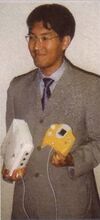
Sega were thought to have been showing off development hardware to prospective developers and publishers around late 1997, with a converted demo version of Scud Race[3]. Notably the Sega Saturn had built a reputation of only offering arcade conversions - with the Dural, Sega wanted a more diverse selection of games, and so despite experimenting with Scud Race, a full conversion of the title was unlikely. The upcoming Daytona USA 2: Battle on the Edge was considered a more likely candidate, but in the end this did not materialise either.
Incidentally demos concerning Scud Race have since been found on Dreamcast Dev.Boxes.
"Katana"
In early 1998 the Dural project publically became known as "Katana", at a time when Sega Saturn was on its last legs. Electronic Arts dropped its Saturn support and Western versions of X-Men vs. Street Fighter seemed increasingly unlikely - a new console was sorely needed, and Sega Europe were setting a date for 1999[4].
Initially, Sega decided to use Yamamoto's design and suggested to 3Dfx that they would be using their hardware in the upcoming console, but a change of heart caused them to use Sato's PowerVR-based design instead. There are conflicting reports claiming whether the "Katana" was more powerful than the "Blackbelt" or vice versa - Sonic Team and Dreamcast developer Yuji Naka was caught in 1998 stating that ports of Sonic Adventure to the PC was impossible, because 3DFX's Voodoo cards were significantly less powerful than what was in the Katana console. It was also suggested that the Black Belt would cost more to produce and deliver less, making it uncompetitive.
The choice to go for the Katana project puzzled Electronic Arts, a longtime developer for Sega's consoles. EA had invested in the 3Dfx company and were unaware of VideoLogic's creations, and this difference of opinion, as well as poor Saturn sales, may have attributed to why the publisher refused to back the Dreamcast in its final iteration.
Sega's decision has also been attributed to 3Dfx leaking details and technical specifications of the then-secret Dreamcast project when declaring their Initial Public Offering in June 1997. In response, 3Dfx filed a $155 million USD lawsuit in September against Sega and NEC, claiming that they had been misled into believing that their technology would be used when in fact a back-room deal had been done between the two Japanese companies in the months prior to the announcement. They also claimed that Sega deprived 3Dfx of confidential materials in regards to 3Dfx's intellectual property.
The lawsuit was settled in August 1998, with Sega paying USD $10.5 million to 3Dfx. Sega made massive losses around this period, with many staff layoffs making the news.
In early 1998 it was confirmed that the PowerVR Series II was chosen for the Katana, but there were also reports that the Black Belt project had not gone entirely to waste - the Katana's operating system had been tweaked to make it just as easy to use and develop for as the American system.
It seemed as if Microsoft no longer had a role in the console's development, however 1998 was also the period where they announced another operating system was available to Katana users - one based on its Windows CE technologies. Initially it was thought the Dreamcast could be bridging the gap between home PCs and video game consoles, however this was revealed not to be the case. Windows CE was intended to attract developers from Windows 95/98, presenting a less daunting development environment for those who had not worked on consoles before.
Microsoft decided to cooperate with Sega in an attempt to promote its Windows CE operating system for video games, but Windows CE for the Dreamcast showed very limited capabilities when compared to the Dreamcast's native operating system. The libraries that Sega offered gave room for much more performance, but they were sometimes more difficult to utilize when porting over existing PC applications. Numerous Sega executives have gone on record stating that they felt the native OS was faster and more powerful.
There were also troubles with Electronic Arts. Sega's financial position meant they were unable to offer the same generous offers which kept the company by their side in previous generations.
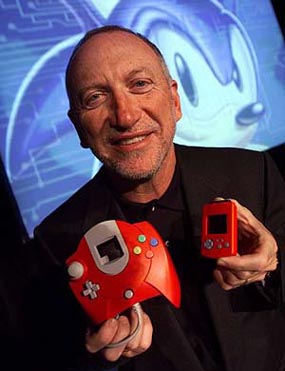
Then-CEO of EA, Larry Probst (a friend of Bernie Stolar) allegedly put forward a deal which only saw EA sports games being released on the Dreamcast platform for five years, potentially leading to market dominance. Sega could not meet the terms of this agreement, and neither did they appear to want to - Visual Concepts was bought by Sega for USD $10 million and the widely held view was that their next NFL game (NFL 2K) would out-perform the likes of Madden 2000. Sega attempted to get a better offer for them, but EA would not budge, leading to a Dreamcast without any support from the company at all.
During the first half of 1998 several details were leaked concerning the Katana project and a similar Sega Model 3 arcade replacement, the "NAOMI project", such as the concept of memory cards with built-in screens and a built-in modem[5]. Later, talk of proprietary disc formats, NAOMI-Dural memory card relationships and the name "Dream" appearing in the system's name[6].
Sega New Challenge Conference
On the 21st May, 1998 the Dreamcast console was shown to the world for the first time, at a Sega press event, the Sega New Challenge Conference. The intention was to release the system in Japan in November 1998. Supposedly the console was set to be revealed on the 10th, but this clased with the announcement of Square Enix's Final Fantasy VIII[6].
Sega's tactics were unusual for Japan - the Dreamcast would be supported along with the Saturn, primarily handling 3D titles. The Saturn would do 2D, however the move to announce the Dreamcast was seen by many Japanese developers as unnecessary solely because the Saturn was holding its ground quite nicely. Sega had expected a PlayStation 2 to be released in late 1999 (it was actually early 2000) and wanted to build up a year's worth of titles in advance to stall Sony's efforts. Similarly, delays in western regions were put in place to give the console a strong launch lineup.
By mid-1998 the internals of the Dreamcast had been finalised, though a final colour had not yet been chosen. Interestingly Sega had originally planned to distance its company name from the brand - unlike production Dreamcasts (and North American advertising), no "SEGA" lettering was to be found on the console, likely in an attempt to hide the history of the Saturn, Sega 32X and Sega Mega-CD.
Windows World Expo Tokyo 98
Between the 1st and 4th of July, 1998, Microsoft held their own Japanese expo for upcoming Windows products. Among those, the Windows CE-compatible Dreamcast, still not in its final form.
Unlike the Sega New Challenge Conference where prototype Dreamcasts were kept in glass cases or behind closed doors, here the console could be picked up and even powered on, confirming that "something" was in the shell, even though it wasn't connected to a television.
The Dreamcast on display still lacked its final shell, as evidenced by the lack of "Powered by Windows CE" text next to the controller ports. Instead, a crudely attached sticker was placed on the front of the console, with a promise that the final version would have this message printed on the shell itself[7].
Sega New Challenge Conference II and Tokyo Game Show '98 Autumn
Held a few days before Tokyo Game Show '98 Autumn, Sega detailed its pricing strategy and launch titles, and tied up loose ends about what the final console package would contain. At TGS Dreamcast games were made available to the public for the first time, and Sega detailed its internet strategy.
The year long gap between the Japanese and Western releases of the Dreamcast saw a few important events. It is said that Bernie Stolar went against his Japanese superiors by pricing the Dreamcast with a launch price of USD $199 (which he unveiled in a speech in early 1999, to standing ovation). Reportedly, Sega Japan wanted to price the DC at USD $249 in order to be very profitable right from the start. Stolar was fired before the Dreamcast's launch.
Issues were also raised with the PAL variant of the Dreamcast console. Its logo was feared to infringe trademarks with German publisher, Tivola. This is why PAL logos are blue.
Prototypes
The following three prototype Dreamcasts were displayed at TGS Autumn '98:
"Bread Bin" Design
Though most prototype designs were confined to the drawing board, Sega produced a few physical prototypes, the most radical is this "wedge" or "bread bin" design, unlike any video game console released before or since. This is apparently cited as being the "first" prototype, or at least, earlier than the two which follow.
It appears to sport four controller "ports" and has a lid, where presumably games would be inserted. It is grey and lacks names or logos.
"Black Box"
The second design is far more similar to the final product, though seems to be taking design lessons from the western Sega Saturn. The four controller ports are now housed at the front, similar to the Nintendo 64, and there are two buttons, one to presumably open the lid, and another to turn the unit on. It is clear from this stage that the reset button of the Saturn would not be included in the Dreamcast.
It is possible that this is the BlackBelt design, for it is quite literally black.
"White Box"
The third iteration is far more similar to the final product. It is now white, has a power LED and a window to see the disc spinning (which would be omitted from the final design).
Others
Controller
The Dreamcast controller was derived from the Sega Saturn's 3D Control Pad. Every prototype Dreamcast controller acknowledges the need for an analogue stick.
Air NiGHTS Controller
Yuji Naka was involved in the Dreamcast project during its conception, though inevitably got caught up in Sonic Adventure's development towards the end. It is rumoured, however, that the NiGHTS into Dreams team influenced a design of the Dreamcast controller - one built like a remote and with motion sensors, almost a decade before the Wii entered the market. It was to be used in conjunction with the Air NiGHTS project.
Visual Memory Unit
Early VMU designs looked similar, if not more colorful, than the final product.
Release
Japan
Japan's relationship with the Dreamcast is hard to judge, as its release is often considered to be premature. The Sega Saturn had been a successful venture for the company, and Japanese publishers failed to see the need for a new console, so when the system debuted on the 27th of November 1998 in Japan, the demand was perhaps less significant than in the West.
Sega's initial strategy was to run the two consoles in parallel, 2D games being housed on the Saturn and 3D on the Dreamcast, though this became less and less tennable as time went on.
Four titles were available at launch: July, Pen Pen TriIcelon, Virtua Fighter 3tb, and Godzilla Generations. Within three days 140,830 consoles had been sold (of the 150,000 available units, bearing in mind this figure includes promotional and development units). Virtua Fighter 3tb was the biggest seller (debuting second in the software charts of that week), followed by Godzilla (16th), Pen Pen (21st) and July (25th).
A Japanese launch generally sees the console effectively sold out at launch, as the vast majority of systems and games are pre-ordered weeks and months in advance. In the Dreamcast's case this led to some criticism, as the four launch titles were not well received by much of the gaming press. Furthermore Sega put a lot of spin in its press releases - while the console was indeed sold out and shortages were common throughout the Christmas 1998 period (as "demand outstripped supply"), this was because of a shortage of PowerVR 2 graphics chips. As NEC was unable to produce enough components (about 30% of what was anticipated), Sega's initial projection of 300,000 units was effectively halved.
The original plan was to release one game a week for four weeks following the launch, Blue Stinger on the 3rd of December, Geist Force on the 10th, Sonic Adventure on the 17th and the combined batch of Evolution, Incoming, Monaco Grand Prix: Racing Simulation 2 and Seventh Cross Evolution on the 23rd. However half of these titles were delayed at the last minute, many being pushed back to March 1999 and Geist Force being cancelled outright. Planned launch title Sega Rally 2 was also affected, being knocked back to January, while Sonic Adventure saw a two week delay.
However, roughly one in three consumers logged onto the internet using the bundled Dream Passport service, which greatly exceeded expectations.
Initial predictions by Sega were that the PlayStation 2 would debut in late 1999 (it was actually early 2000 in Japan). The aim was to attract as many developers as possible within a year to attempt to secure the Dreamcast as the number one consoles of its generation. A 1 million units sold target for March 31st was set by management, though in the end the shipping figure is thought to have been around 900,000 across Asia, with potentially about 800,000 units actually sold (no official figures exist for this period and are third-party estimates from across Q2 1999).
With the Mega Drive, Sega had identified the US and Europe as the largest video game markets. With the Saturn and Dreamcast, they felt (perhaps wrongly) that Japan was the key territory. As such, like the Saturn, the Dreamcast was subjected to many games exclusive to Japan, along with numerous exclusive peripherals and special Dreamcast models.
Japanese Dreamcasts can be identified by the triangle at the front of the unit. Though the power LED is identical across all regions, the piece of plastic attached to the lid of the Japanese model is transparent, while in North America it is grey.
North America
The US had to wait nearly a full year for their Dreamcasts - Sega executed a massive launch on the 9th of September 1999 (9/9/99). Shoichiro Irimajiri claimed this was so the Dreamcast could launch with wider variety of games (it ended up being 4 (JP) vs. 18 (US)), and the first time a Sega console would launch with "enough" games.
Dreamcast pre-orders were said to be around the 200,000 mark - roughly twice the amount of pre-orders for the original PlayStation in 1995 and enough for Sega to claim it was the most anticipated video game console in history. Its year long delay also came with some advantages - games such as Blue Stinger were able to be improved for their Western releases.
The Dreamcast took in over $97 Million USD on the first day of launch in North America, and sold over 500,000 machines in the first two weeks, nearly 400,000 of which were in the first four days. Sega were quick to point out that $97,000,000 is more than Star Wars: The Phantom Menace brought in its opening weekend (roughly $65 million). Over a million machines were sold in North America in just over two and a half months, making the Dreamcast the fastest selling video games machine in that region, ever.
Sega Dreamcast's motto in the US was "It's thinking". There was some confusion with Sega's marketing tactics at the time, as adverts often failed to address what was thinking. It was not always clear that the Dreamcast was a games console.
But the Dreamcast was met with problems when rumours of Sony's PlayStation 2 came into circulation. Many consumers held back from buying Dreamcasts, anticipating that Sony's console would be superior. Predictably, the PlayStation 2 proved to be a more capable machine, and despite its relatively weak initial library of games, came out on top due to the inclusion of DVD-playback capabilities. At the time, DVD players were quite expensive, so the PS2 was seen as a much better deal. Furthermore, backwards compatibility with the original PlayStation gave it five years worth of compatible software from the get go.
By the mid-2000s Sega were offering Dreamcasts for free, should users sign up with Seganet as their internet service provider.
Production of North American Dreamcasts ceased in November 2001, several months after Sega announced plans to leave the console business. Despite this, the Dreamcast is seen to have been more successful than the Sega Saturn (and Sega Master System) in this region.
Europe
Much like North America, the Sega Saturn was out of the picture by 1998, considered to have been a "failure" and no longer a viable platform for video game development. Like the US, this gave competitors an almost two year advantage over Sega.
The UK, being the largest games market in Europe, was again the centre of attention for much of Sega's European operations. The PlayStation had been ahead since 1995, but rather than being challenged significantly by the Nintendo 64, extended its lead with blockbusters such as Gran Turismo, Final Fantasy VII and Metal Gear Solid. Nintendo was still in the race, but was beginning a long-running trend of having very little software to choose from - only about 120 N64 titles were available on the UK market by mid-1999, though the system had been on sale since March 1997.
Roughly 50 games had been greenlit for a European release by July 1999.
After long speculation about whether the European Dreamcast would have a built-in modem, the system was given the same 1999-09-09 release date as in the US... before it was subsequently pushed back to the 23rd of September, and then at the last minute, the 14th of October 1999. The delay was reportedly down to BT's handling of the Dreamarena service in the UK, and such was the commitment to online Sega Europe refused to release the console until this service was done.
It was priced at £199.99 in the UK - the cheapest video game console release on record (though on import US and Japanese machines would have costed around £150 and £130, respectively). There were various festivities during the launch night, notably boxers Chris Eubank and Nigel Benn fighting for the first time since 1993... through Ready 2 Rumble Boxing. 3,000 uses registered on Dreamarena in the first 24 hours.
Initial European sales figures looked healthy, with over 100,000 machines sold in Europe on launch day alone (42,000 of those being UK pre-orders) and over 185,000 in the first weekend. By Christmas weekly hardware sales in the UK were doubling that of the Nintendo 64, though were significantly less than the cheaper PlayStation. Dreamcast games were also retailing for about £40 - £20 less than some of the N64 big hitters such as Donkey Kong 64.
Sega Europe set a target of one million units sold by May 2000. About 500,000 had been sold by Christmas, and the Dreamcast was responsible for about 5.4% of video game console sales (including handhelds) in 1999 (Game Boy 9.1%, Nintendo 64 15.4%, PlayStation 69.4%, others 0.7%).
Despite being noticably smaller than Japan and the US, the Dreamcast library was widely praised in the UK, likely as a result of decisions not to publish games that fared poorly in other regions. However, desipte this Sega had a hard time selling software - very rarely did a Dreamcast game make it into the weekly top 20 sales charts, and while a typical first-party Sega game could appeal to the gaming press, its new ideas and untested intellectual properties were sidelined by the general public, which typically opted for brands it knew on the PlayStation.
On 8 September 2000, Sega Europe reduced the price in the UK to £149.99[8] in response to the arrival of the PlayStation 2, but despite delays, hardware shortages, a higher price point and limited array of launch software, Sony's machine, complete with the backing of many third-party publishers (and 300+ games announced for the system before launch), ultimately eclipsed the Dreamcast within six months of sale.
After news of the impending cancellation of the Dreamcast in 2001, the system's price was lowered to £99.99 on the 14th of February[9].
Despite this, the Dreamcast did last longer in Europe than in North America, and was officially discontinued in the spring of 2002.
Australia/New Zealand
The Australian region the launch was labeled a disaster by many fans of Sega. Ozisoft, the official Sega distributor in Australia, only managed to output nine launch titles despite the late release date (November 30, 1999), none of which were first party products. Apparently Sega-developed software had been held in customs and could not reach store shelves by the release date (which included Dream On demo discs, which had to be picked up by customers at a later date).
With no VMUs or other peripherals on the market, it seemed that after what seemed like infinite delays, Australian fans deserved better. Moreover no Australian advertising campaign came into force until the system had been released - the general public could have easily been taken unaware.
The Dreamcast took a while to get online in Australia, arriving in the back end of Q1 2000. A deal between Telstra and Ozisoft saw comma.com.au become the default Dreamcast homepage, powered by a similar Dreamkey service to Europe.
Generally the console isn't thought to have done well in Australia, with retailers such as The Games Wizards pulling the system within six months of sale.
Brazil
Tectoy, who had been responsible for distributing Sega consoles in Brazil since the Sega Master System, brought the Dreamcast to Brazil on October 4, 1999. The majority of games were repackaged titles imported from the US, and the console was not particularly successful.
South Korea
Breaking from the tradition of partnering with Samsung, in South Korea the Sega Dreamcast was reportedly distributed by Hyundai, the company who, curiously, had carried Nintendo products in the country during the 90s. Unlike the rest of the world, the Dreamcast arrived late in South Korea and was priced as a budget console competing against the PlayStation 2 and Xbox. 25,000 units were shipped before Hyundai cancelled the project for unknown reasons. South Korean Dreamcasts were supposedly bundled with modem cables to take advantage of the system's online services.
Some Korean developers were reportedly developing games for the Dreamcast before the plug was pulled. Arcturus and White Day, both eventually released on the PC, were once set to be released on the console.
Decline
The true reasons for the Dreamcast's dimise are the subject of debate, however on January 31, 2001, Sega announced an end date for the hardware - March.
In the mid-1990s, riding off the success of the Sega Mega Drive and their mascot, Sonic the Hedgehog, Sega had embarked on overly ambitious plans - to be the largest and most dominant video game force on the market, and a world leader in entertainment - a Japanese equivalent to Disney. But struggles with the Saturn and other pressures came back to bite the firm - by the late 1990s Sega were making heavy losses, and the empire was put on hold.
May 2000 saw Isao Okawa replace Shoichiro Irimajiri as president of Sega. Hayao Nakayama, who had also been in the chair during Sega's rise to fame was also out the door, and Okawa (who had invested heavily in Sega - having loaned the firm $500 million USD in 1999) lacked the faith of these two men. Okawa did not want Sega in the console business, and his vision of a third-party software developer was shared by many of the big Sega names in America, including Peter Moore and Charles Bellfield. Former Sega grandee David Rosen also had his doubts, and despite initial reluctance, Sega of Japan finally pulled the plug on the Dreamcast project.
It is widely considered that Sega were unable to compete with Sony's PlayStation 2 and Microsoft's new Xbox console when it came to marketing. The Xbox advertising campaign eclipsed anything Sega could put together, and was cited as a reason not to continue. However, it is known many in Sega were symphathetic to Microsoft's cause - Bernie Stolar for example (now in charge of Mattel), advocated a deal which saw Microsoft buying Sega and working on a joint platform. Others were wary that the big names of Electronic Arts and Square Enix, third-party leaders in the US and Japan, respectively, were still not on board the Dreamcast project, and others such as Eidos and Infogrames had already severed ties with the system.
Sega's money issues would become a serious problem in the years that followed. A failed merger with Bandai and reported talks with Namco came to nothing, and having resisted a buy-out from Sammy, the two companies merged in 2004, creating Sega Sammy Holdings which would drastically streamline the organisation. Nearly one-third of the Tokyo workforce was laid off in 2001, the company didn't make a profit until 2003, after five years of consecutive losses.
From a software point of view, however, the Dreamcast was frequently praised. Hardware shortages plagued the early years of the PlayStation 2, and the Dreamcast is thought to have achieved more in eighteen months than the Nintendo 64 had managed in five years. Furthermore the Dreamcast could boast many features the PlayStation 2 could not - while it lacked the native DVD playback capability (an extremely significant factor in 2000/2001), it would take many years until a competitor could match Sega's online presence.
Dreamcast games almost always ran in 640x480 (versus the usual 512x448 for PS2 titles), often with PAL60 support for European and Australian markets, and in most cases picture quailty that could go up to VGA standard. Even Nintendo's Wii, released as late as 2006 lacks a comparable video option. Sony were late to pick up some ideas, such as allowing more than two players to use the system locally (without add-ons), and it was a while until the PS2 could match the Dreamcast's low price and physical size.
No evidence seems to suggest that the Dreamcast failed to sell, just that the markups on hardware and software were not sufficient to counteract other financial pressures in the company. Building games for a range of systems, therefore increasing potential profit, was considered the more logical move.
Aftermath
Abandoned projects
With the Sega Saturn, video game projects were being dropped as early as 1997 on the grounds that supporting the hardware was unprofitable. While the Dreamcast suffered from many drop-outs in late 2000, significant amounts of software were still in active development in 2001. Many of these, including internal Sega projects, would find themselves being converted to the Xbox or PC.
In fact, most of Sega's third-party offerings in 2001 and 2002 originated on the Dreamcast, be it straight up ports of Crazy Taxi, or unfinished Dreamcast games such as Gunvalkyrie and ToeJam & Earl III: Mission to Earth.
Internet
While consoles with varying levels of internet support can be traced back several decades (for example, the Sega Saturn's NetLink Internet Modem and the Mega Drive's Sega Mega Modem), the Dreamcast is widely considered to be the first console to provide online support for all of its users from day one, owed to the existence of a built-in modem. Furthermore, access was free for much of its existence, including the ability to play against other humans online.
Sega's plans are generally perceived to have been ahead of their time. Much of Sega's corporate structure had been changed in the late 1990s to reflect the concept of online play, but most third-party publishers were unwilling or unable to mirror this enthusiasm until the mid-2000s. For many, the concept of prolonged use of the internet was still a pipe dream, as prices were high and speeds were low. 33.6kB or 56kB modems were unsuited to complex games (not to mention products such as the Dreamcast Microphone and Dreameye), and while a Dreamcast Broadband Adapter was released, it took until 2001 and failed to reach PAL regions.
Nevertheless Sega persued the concept of online gaming through the likes of Phantasy Star Online and its sequels, and with the introduction of Xbox Live and the subsequent "seventh generation" of consoles (starting with the Xbox 360 in 2005, online gaming and interaction similar to how Sega had envisoned it is now the norm.
Lessons
Sports games
Sega's failure to secure a deal with Electronic Arts is thought to have been a significant factor in the Dreamcast's Western decline during 2000. While the likes of Visual Concepts were able to bring out comparitive and often better experiences with the 2K range, the sector can make or break a console's relationship with the mass market. Fundementally the Dreamcast didn't have Madden or FIFA, the dominant sports franchises for American and association football, respectively.
While the throwaway and incremental nature of sports titles are not always looked on favourably, it was the genre of gaming that kept the Sega Mega Drive (or Genesis) relevant in North America, and was a key reason to side with the PlayStation 2 and later Xbox. More importantly, Sega spent a great deal of time in North America marketing the system as a home for sports games - from the beginning, advertising featured NFL players, and even a Sega Sports-branded Dreamcast was released.
Unlike the Sega Saturn, the Dreamcast lacked a product that could surpass more modern outings of FIFA. Earlier attempts such as UEFA Striker, Sega Worldwide Soccer 2000 and Sega's own Virtua Striker 2 Ver. 2000.1 were given mixed reviews by critics (though Virtua Striker 2 opts for a more fast-paced arcade-style mode of play rather than a "simulation"), but while Sega Worldwide Soccer 2000: Euro Edition was a marked improvement, most commentators cited the PlayStation and Nintendo 64 as better places to play football games.
Legacy
The Sega Dreamcast is a fan favourite, and discussions of a so-called "Dreamcast 2" (and/or a new video game console to bring Sega back into the hardware business) have been going on since 2001. Dreamcasts are regularly referred to in Sega media, and several Dreamcast games have been re-released for newer consoles (and compiled in the form of Dreamcast Collection - though purists will note that neither of these four games came straight from the Dreamcast).
Most notably, the semi-open nature of the hardware means that the supply of Dreamcast games has been constant since its supposed demise, with independent studios releasing games over a decade after official support for the console was dropped.
Tech Demos
HKT-01 Demos
Various demos can be found in Dreamcast development kits, including more of Scud Race, the FMV introduction of Sonic 3D: Flickies' Island, the infamous teapot often used for graphical tests, etc.
References
- ↑ File:Edge UK 025.pdf, page 6
- ↑ File:Edge UK 030.pdf, page 6
- ↑ File:Edge UK 054.pdf, page 12
- ↑ File:Edge UK 055.pdf, page 8
- ↑ File:Edge UK 058.pdf, page 11
- ↑ 6.0 6.1 File:Edge UK 059.pdf, page 9
- ↑ File:GamersRepublic US 04.pdf, page 12
- ↑ http://sega.jp/corp/release/2000/0901_3/
- ↑ File:ODM UK 18.pdf, page 19

